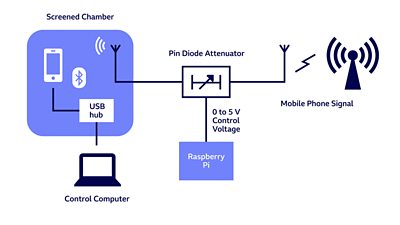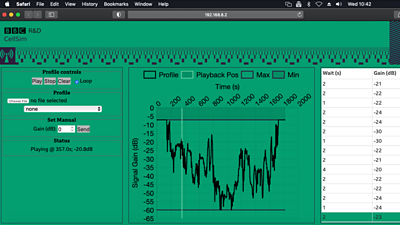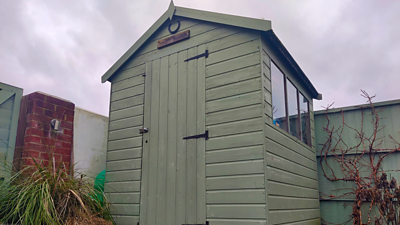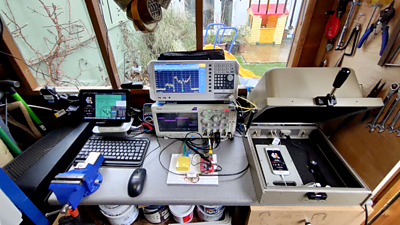As our audiences make ever-increasing use of our online services such as ΒιΆΉΤΌΕΔ iPlayer and ΒιΆΉΤΌΕΔ Sounds on mobile devices, we need to make sure we have the tools to test them that mirror the usersβ experience in real-world environments. Mark Waddell and I been working with the developers of the ΒιΆΉΤΌΕΔβs Standard Media Player (a common component used across our apps) to build CellSim, a 4G/5G test system that mimics the natural fading of mobile (cellular) network signals in a controlled and repeatable manner.

The problem
Fading mobile signals are likely to be familiar to anyone who has tried to stream audio or video away from home. Features such as hills, buildings, tunnels or bridges can inevitably block mobile signals, and any holes in coverage can result in breaks in reception. When developing media players in applications such as ΒιΆΉΤΌΕΔ Sounds, the aim is to try to manage these breaks in ways that minimise disruption to the viewer or listener by, for example:
- using a sensible buffering strategy,
- selecting the appropriate bit-rate representation for the conditions and
- an appropriate retry policy to ensure that, ultimately, if playback does pause, it restarts automatically.
Given the variability of mobile signals in the real world, it can be difficult to recreate specific conditions in a repeatable way that lends itself to testing and optimising the media playback experience. Meanwhile, commercial, off-the-shelf mobile channel emulator systems are typically extremely expensive and, while capable of recreating detailed echoes and reflections, do much more than is required for this purpose.
The solution - CellSim
Building on our experience with testing and creating our own mobile networks from projects such as 5GRuralFirst, we've been working with the ΒιΆΉΤΌΕΔ's mobile app engineering teams to develop the CellSim system. This uses an antenna to receive the normal signal from the mobile network, pass it through a computer-operated level control and deliver it to a phone inside a screened chamber (designed to keep out all signals apart from the one we feed to it).

The level control is based on a 'pin diode' attenuator, which will vary the level of the signal through it depending on a control voltage applied to it. We use the Pulse Width Modulation (PWM) output of a Raspberry Pi (via a suitable filter and op-amp to boost the level appropriately) to generate the voltage. The Raspberry Pi runs some node.js code to provide a RESTful interface that enables a web application to interact directly with the PWM output.

The user interface of the web application allows the user to enter a signal level manually as well as load in a pre-defined 'profile' of varying signal levels. This could be based on a particular pattern of signal levels of interest. We also have the option to record the signal levels from a real-world test device that we could use to recreate the signal conditions of a specific journey, commute or jogging route.
ΒιΆΉΤΌΕΔ R&D - Broadcasting Over 5G - Delivering Live Radio to Orkney
A testbed in a shed
When the COVID-19 pandemic struck, resulting in us working from home, we faced a challenge. How to complete the development of the system (which at the time was just a breadboard circuit based on components from our lab stock and a back-of-the-envelope sketch) without having access to the extensive technical facilities in our southern R&D lab, the Lighthouse?

The pragmatic answer was to ship some kit home and set it up where space was available, namely my shed. This had the advantage of being out of the way and suitable for a long-term setup, as well as having a mains power supply and being within range of the home WiFi network.

This approach allowed development of both the software and hardware to continue, using a mixture of items delivered directly to home and hardware components from my personal store.
Remote control
We also faced the added challenge of transferring the system to the developers to use it for real. Whereas the original intention had been to ship a complete physical unit for them to use, it became increasingly clear that homeworking would be the norm for some considerable time to come. In consultation with the Standard Media Player's developers, we decided that the only viable way forward was for them to have full remote control of the system.
This generated particular challenges around how to allow remote viewing and control of a phone locked away inside the screened chamber. After some considerable head-scratching, we found a solution, using a Bluetooth hub placed inside the screened box and using the phone's accessibility features alongside a computer mimicking a Bluetooth keyboard and mouse to control it.
Completing the system
Despite having very restricted access to our lab, our in-house CAD team have been working on designing and manufacturing a proper enclosure for the system to house the pin diode attenuator, Raspberry Pi and associated wireless access point to replace the homemade one. This makes for a properly finished product and puts us in a position to deliver a physical system as needed in the future.

βΒιΆΉΤΌΕΔ R&D has come up with a great solution to testing our products in more realistic ways. This will help us improve the experience of ΒιΆΉΤΌΕΔ Sounds users once they start commuting again.β
Chris Brabon, Senior Project Manager in Media Services
Next steps
The next steps are to formally hand the system over to the development teams and for them to do more extensive testing. We can also look to collect signal data on any routes that cause particular playback issues and factor these into the testing process. Finally, there's a question of integrating CellSim within the normal test-driven development process for ΒιΆΉΤΌΕΔ Sounds.
Conclusion
This work is part of our for both distribution and content production. In developing CellSim we're applying ΒιΆΉΤΌΕΔ Research & Development's extensive 4G, 5G and RF expertise to help the ΒιΆΉΤΌΕΔ's engineering teams deliver the best online products possible. As we move to a future of IP delivery, we are ensuring that as many people as possible get the best experience possible from iPlayer and Sounds, wherever they are.
-
ΒιΆΉΤΌΕΔ R&D - All of our articles on 4G and 5G including:
ΒιΆΉΤΌΕΔ R&D - Broadcasting Over 5G - Delivering Live Radio to Orkney
ΒιΆΉΤΌΕΔ News - 5G: Why Orkney Got the Latest Tech Before London
ΒιΆΉΤΌΕΔ R&D - 4G Broadcast: Can LTE eMBMS Help Address the Demand for Mobile Video?
ΒιΆΉΤΌΕΔ R&D - 5G Trials - Streaming AR and VR Experiences on Mobile
ΒιΆΉΤΌΕΔ R&D - 5G Smart Tourism Trial at the Roman Baths
ΒιΆΉΤΌΕΔ R&D - New Content Experiences over 5G Fixed Wireless Access
ΒιΆΉΤΌΕΔ R&D - New Audience Experiences for Mobile Devices
ΒιΆΉΤΌΕΔ R&D - Unlocking the Potential of 5G for Content Production
